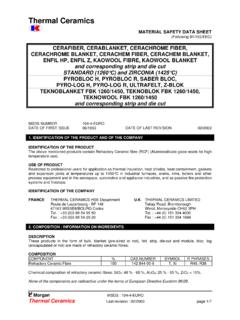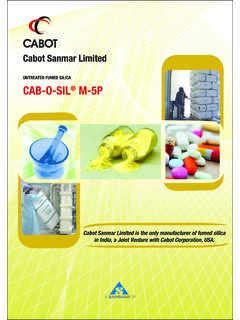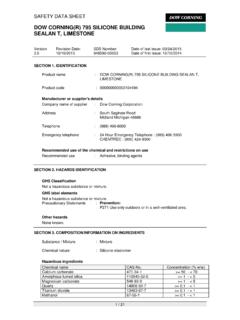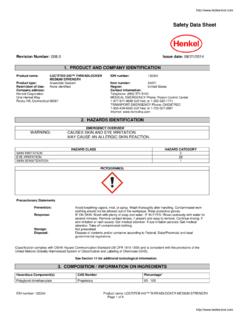Transcription of MATERIAL SAFETY DATA SHEET - Lloyd R.I.S
1 MorganMSDS : DC1-3-EUROT hermal CeramicsLast revision : 12/2002page 1/6 Thermal CeramicsMATERIAL SAFETY data SHEET (Following 91/155/EEC)STANDARD, EMCAST, EMCAST LI, EMCAST CLI, HT CAST, MORCAST,1700 CAST, SUPERCAST, 160F CASTABLE, MULCASTMSDS NUMBERDC1-3-EURODATE OF FIRST ISSUE05/1995 DATE OF LAST REVISION12/20021. IDENTIFICATION OF THE PRODUCT AND OF THE COMPANYIDENTIFICATION OF THE PRODUCTThe above mentioned products are dense OF THE PRODUCTT hese products are monolithic refractories used in lining industrial furnaces, high temperature processing,kilns and metal melting OF THE COMPANYFRANCETHERMAL CERAMICS HSE CERAMICS LIMITEDR oute de Lauterbourg - BP 148 Commercial Road, Bromborough67163 WISSEMBOURG CedexWirral, Merseyside CH62 3 NLTel.
2 : +33 (0)3 88 54 95 50 Fax : +33 (0)3 88 54 29 20 Tel. : +44 (0) 151 334 4030 Fax : +44 (0) 151 343 54372. COMPOSITION / INFORMATION ON INGREDIENTSDESCRIPTIONT hese products are hydraulic setting dense NumberSYMBOLR < 20266-045-5 or < < silica < additives< of the components are radioactive under the terms of European Directive Euratom 96/293. HAZARDS IDENTIFICATIONACUTE EFFECTSMild mechanical irritation to skin, eyes and upper respiratory system may result from effects are usually mixed with water, an increase in pH will occur. Alkaline mix may be irritating to skin and could causedamage to skin and respiratory conditions including dermatitis, asthma or chronic lung disease might beaggravated by exposure.
3 MorganMSDS : DC1-3-EUROT hermal CeramicsLast revision : 12/2002page 2/6 CHRONIC RESPIRATORY HEALTH EFFECTST hese products may contain minimal amounts of crystalline silica . Prolonged/repeated inhalation ofrespirable crystalline silica dust may cause delayed lung injury (silicosis).IARC (International Agency for Research on Cancer) states that there is "sufficient evidence in humans forthe carcinogenicity of inhaled crystalline silica in the form of quartz or cristobalite from occupational sourcesto classify crystalline silica as carcinogenic to humans (Group 1)" (Monograph V 68). In making the overallevaluation the Working Group noted however that carcinogenicity in humans was not detected in allindustrial circumstances FIRST-AID MEASURESSKIN:In case of skin irritation rinse affected areas with water and wash gently.
4 Do not rub or scratch exposed :In case of eye contact flush abundantly with water; have eye bath available. Do not rub AND THROAT:If these become irritated move to a dust free area, drink water and blow symptoms persist, seek medical FIRE-FIGHTING MEASURESNon combustible and surrounding materials may be extinguishing agent suitable for surrounding combustible ACCIDENTAL RELEASE MEASURESPERSONAL PROTECTIONP rovide the workers with appropriate protective equipment until the situation is restored to normal (seesection 8). Prevent further dust dispersion for example by damping the FOR CLEANING UPUse a vacuum cleaner fitted with a high efficiency filter. If brushing is used, ensure that the area is wetteddown first.
5 Do not use compressed air for clean PROTECTIONDo not allow being wind blown. Do not flush spillage to drain and prevent from entering naturalwatercourses. For wastes disposal refer to section HANDLING AND STORAGEHANDLING/TECHNIQUES TO REDUCE DUST EMISSIONS DURING HANDLINGH andling can be a source of dust emission. The process or processes should be designed to limit theamount of handling. Wherever possible handling should be carried out under ventilation with filtered good housekeeping will minimise secondary dust in original packaging in a dry area. Avoid damaging the packaging. MATERIAL supplied in multi-ply papersacks or big USE:Please refer to your local Thermal Ceramics supplier or ECFIA s website.
6 MorganMSDS : DC1-3-EUROT hermal CeramicsLast revision : 12/2002page 3/68. EXPOSURE CONTROLS / PERSONAL PROTECTIONHYGIENE STANDARDS AND EXPOSURE LIMITSI ndustrial hygiene standards and occupational exposure limits vary between countries and local which exposure levels apply to your facility. If no regulatory dust or other standards apply, a qualifiedindustrial hygienist can assist with a specific workplace evaluation including recommendations for respiratoryprotection. Examples of exposure limits for respirable dust (in January 2002) are given below:EXPOSURE LIMIT*COUNTRYR espirableDustCrystallinesilicaQuartzCris tobaliteSOURCEG ermany6 mg/m3 TRGS 900,France5 mg/m3D cret 97-331 du 10 mg/m3 HSE - EH40* Gravimetric concentrations of respirable dust 8-hour time weighted CONTROLSR eview your applications in order to identify potential sources of dust exposure.
7 If necessary, conductpersonal air monitoring. Use technical and/or organisational means to comply with PROTECTIVE EQUIPMENTSkin protection:Use of gloves and work clothes is clothes should be cleaned before being taken off ( use vacuum cleaning, not compressed air).Eye protection:As necessary wear goggles or SAFETY glasses with side protection:For dust concentrations below the exposure limit value, RPE is not required but FFP2 respirators may beused on a voluntary short-term operations where excursions are less than ten times the limit value use FFP2 case of higher concentrations or where the concentration is not known, please seek advice from yourcompany and/or local Thermal Ceramics AND TRAINING OF WORKERSW orkers should be trained on good working practices and informed on applicable local EXPOSURE CONTROLSR efer to local, national or European applicable environmental permitted standards for air, water and soil.
8 Forwaste, refer to Section PHYSICAL AND CHEMICAL PROPERTIESAPPEARANCEMix of white to dark brown aggregates and fine powdersMELTING POINT> 1250 CpH (when is added with water)8-12 SOLUBILITY< 1 % t/m3 MorganMSDS : DC1-3-EUROT hermal CeramicsLast revision : 12/2002page 4/610. STABILITY AND REACTIVITYCONDITIONS OR MATERIALS TO AVOIDC areful heat up of the product is essential to avoid rapid loss of the chemical combined water during heat up(see section 16).DECOMPOSITION PRODUCTSC ontinuous use of these products at temperature above 900 C may lead to the formation of severalcrystalline phases. For further information please refer to sections 3 and TOXICOLOGICAL INFORMATIONA vailable toxicological information is as follows:ACUTE TOXICITYL ethal dose 50 % (LD50) / lethal concentration 50% (LC50): TOXICITYAs manufactured, these products may contain a minimal amount of crystalline study:Animals exposed to very high concentrations of crystalline silica , artificially or by inhalation, have reportedfibrosis and tumours (IARC Monographs 42 and 68).
9 Inhalation and intratracheal installation of crystalline silica in rats caused lung cancer. However, studies inother species such as mice and hamsters caused no lung cancer. Crystalline silica also caused fibrosis inrats and hamsters in several inhalation and intratracheal installation :Prolonged/repeated inhalation of respirable crystalline silica dust may cause delayed lung injury (silicosis).In evaluating crystalline silica as a cancer risk, the International Agency for Research on Cancer (IARC)reviewed several studies from different industries and concluded that crystalline silica from occupationalsources inhaled in the form of quartz or cristobalite is carcinogenic to humans (Group 1) [IARC ; June 1997].
10 However, in reaching its conclusion, IARC stated that the carcinogenicity in humans could not be found in allindustries reviewed and that carcinogenicity might be dependent on inherent characteristics of crystallinesilica or on external factors affecting biological activity ( , cigarette smoking) or distribution of ECOLOGICAL INFORMATIONT hese products are inert materials, which remain stable over the adverse effects of this MATERIAL on the environment are DISPOSAL CONSIDERATIONSW aste from these materials may be generally disposed of at a landfill, which has been licensed for thispurpose. Please refer to the European list (Decision N 2000/532/CE as modified) to identify yourappropriate waste number, and insure national and/or regional regulation are complied into account any possible contamination during use, expert guidance should be wetted, such a waste is normally dusty and so should be properly disposed of in sealed plastic bagsor containers.







